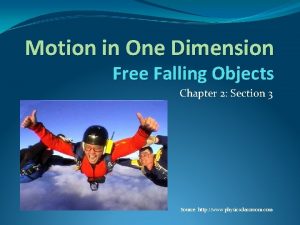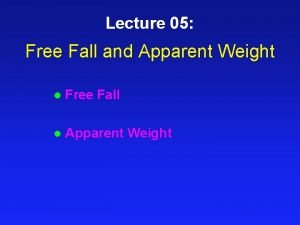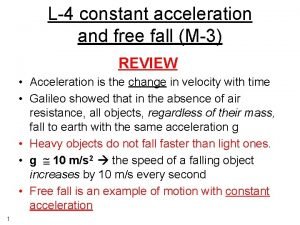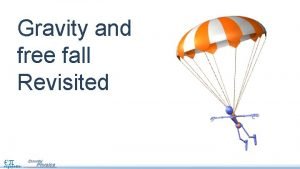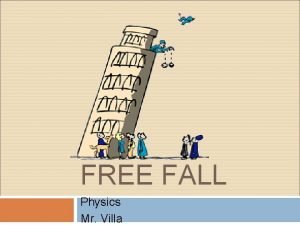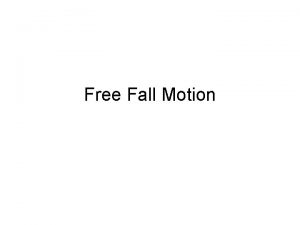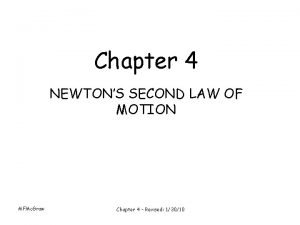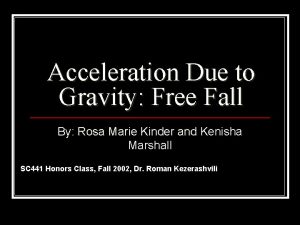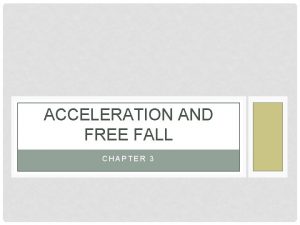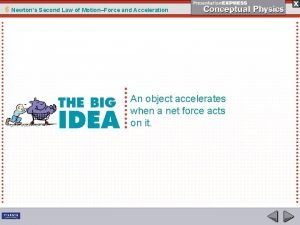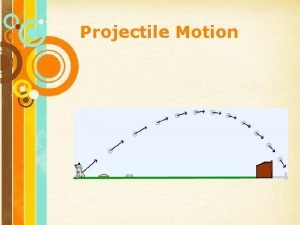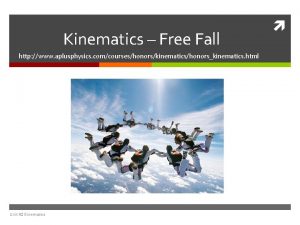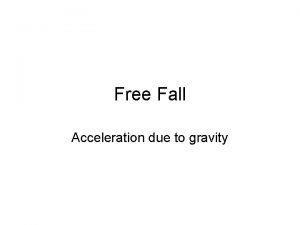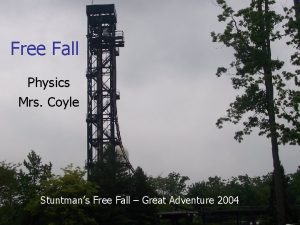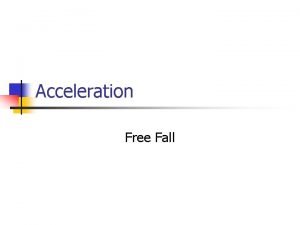Section 3 3 Free Fall In this section












- Slides: 12

Section 3. 3 Free Fall In this section you will: ● Define acceleration due to gravity. ● Solve problems involving objects in free fall.

Section 3. 3 Free Fall Acceleration Due to Gravity After a lot of observation, Galileo concluded that, neglecting the effect of the air, all objects in free fall had the same acceleration. It didn’t matter what they were made of, how much they weighed, what height they were dropped from, or whether they were dropped or thrown. The acceleration of falling objects, given a special symbol, g, is equal to 9. 80 m/s 2 downward. The acceleration due to gravity is the acceleration of an object in free fall that results from the influence of Earth’s gravity.

Section 3. 3 Free Fall Acceleration Due to Gravity Click image to view movie.

Section 3. 3 Free Fall Acceleration Due to Gravity At the top of its flight, the ball’s velocity is 0 m/s. What would happen if its acceleration were also zero? Then, the ball’s velocity would not be changing and would remain at 0 m/s. If this were the case, the ball would not gain any downward velocity and would simply hover in the air at the top of its flight.

Section 3. 3 Free Fall Acceleration Due to Gravity Because this is not the way objects tossed in the air behave on Earth, you know that the acceleration of an object at the top of its flight must not be zero. Further, because you know that the object will fall from that height, you know that the acceleration must be downward.

Section 3. 3 Free Fall Acceleration Due to Gravity Amusement parks use the concept of free fall to design rides that give the riders the sensation of free fall. These types of rides usually consist of three parts: the ride to the top, momentary suspension, and the plunge downward. When the cars are in free fall, the most massive rider and the least massive rider will have the same acceleration.

Section 3. 3 Section Check Question 1 What is free fall? Answer: Free fall is the motion of the body when air resistance is negligible and the action can be considered due to gravity alone.

Section 3. 3 Section Check Question 2 If a stone is thrown vertically upward with a velocity of 25 m/s, what will be the velocity of the stone after 1 second? A. 9. 8 m/s B. 15. 2 m/s C. 25 m/s D. 34. 8 m/s

Section 3. 3 Section Check Answer 2 Reason: Since the ball is thrown upward, the velocity and acceleration are in opposite directions. Therefore the speed of the ball decreases. After 1 s, the ball’s velocity is reduced by 9. 8 m/s (as acceleration due to gravity is 9. 8 m/s 2 downward), so it is now traveling at 25 m/s – 9. 8 m/s = 15. 2 m/s.

Section 3. 3 Section Check Answer 3 Reason: Any body falling freely toward Earth, falls with a same and constant acceleration of 9. 8 m/s 2. It doesn’t matter how much it weighs or what height it was dropped from.

Section 3. 3 Free Fall Acceleration Due to Gravity To calculate the final velocity, use the equation for velocity with constant acceleration. Click the Back button to return to original slide.

Section 3. 3 Free Fall Acceleration Due to Gravity How far does the ride fall? Use the equation for displacement when time and constant acceleration are known. Click the Back button to return to original slide.
